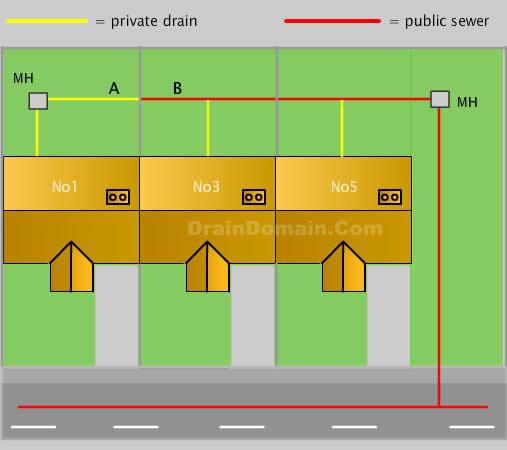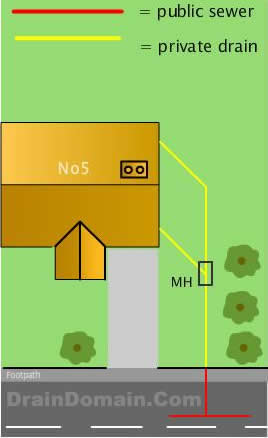DrainDomain.Com - The Free Drainage Advice Site

Drainage Transfer Update July 2011Well its been talked about for a few years and it finally looks as though the transfer of all shared drainage is going to be handed over to the water and sewerage companies on the 1st October 2011. The water and sewerage companies are now trying to bring this to the attention of the wider public and here I will try to explain (not to sure myself at the moment) how this will affect the rate payer and the drainage contractor. The image below shows how after the 1st October the home owner will only be responsible for any private drainage within the boundaries of their property, any shared drainage or private drainage beyond the boundary line will automatically become the responsibility of the water companies.
My initial thoughts are if there is a blockage how will the home owner know where the system is blocked, they will not and can not be expected to know and neither will the person manning the call centre for the water company, As an example if the manhole to the rear of property No1 in the drawing is blocked at point A it is a blockage in a private drain, if the blockage is at point B it is the responsibility of the water company, but how do we find out ?. Surely the private drainage contractor is not expected to measure out his drain rods or jetting hose up to the boundary fence downstream of the manhole and stop at that point if he has not cleared the blockage, presumably he then notifies the water company before packing up and leaving the home owner with an invoice for his time ?. Does the water company appointed contractor ever so carefully push his rods downstream of the manhole in case he disturbs a blockage before he crosses the boundary line, therefore accidentally clearing a blockage in a private system, surely not ?. I suspect a lot of private systems will be cleared at the rate payer’s expense. Drain Repair
They however can not now reline from the manhole because a liner has already been installed up to the boundary, this leaves the option of several localised patch repairs in the section beneath the foot path and road or a good old fashioned disruptive and expensive excavation. Or does the independent drainage contractor liaise with the water company and risk losing the job completely, I suspect not. I should also mention that the things most likely to cause a major problem in a drainage system like tree root ingress, damage due to vehicular movement, impact damage via a fence post or damage resulting from a utility contractor installing a gas main are already covered under your bricks and mortar insurance, the water company in my area kindly advised that we should speak to our insurer to see what impact these changes have on our policy. I think I know what the answer will be, my insurance policy will continue to increase nearly as fast as our water rates when the water companies realise what has hit them. Building Over A Shared SystemThe water companies are not keen on people building within 3 mtrs of their sewers and they definitely do not like people building over them, which is fair enough and if at all possible it should be avoided. However it is not always possible and in most cases there is not enough fall on a system to start diverting pipe work around your new extension, in cases like these the water companies ask that you locate and inspect the sewer at your own expense and submit the information to them., which again is a good working practice so that everyone knows what is where and its current condition. The water companies will then specify what they require from you foundation wise so that you are not affecting their sewer in anyway, and again nothing wrong with that. They can however go belt and braces on these things and I have known simple extensions to cost as much below ground as above due to the requirements of the water companies, I have also been on sites where the size of the proposed build has decreased to avoid the additional cost and at least one site where the guy was told he could not extend at all. Now given that all shared drainage will be classed as a public sewer after October this will affect a lot more people and we can only hope that common sense prevails, I also hope that the independent drainage contractor gets a look in for the inspection works and we don’t end up with a list of preferred water company contractors sent out with every new build application. Only time will tell if the drainage transfer is the best thing to happen in the industry in years or if it will be a complete mess, by the time we know there will be far too many small and medium sized independent contractors out of business.
|



 If the property in the picture to the right has root ingress to the drainage system from the manhole through to the sewer in the road then presumably a drainage contractor can root cut and reline the drain up to the front boundary line, the rest of the run through to the sewer in the road is then the responsibility of the water company.
If the property in the picture to the right has root ingress to the drainage system from the manhole through to the sewer in the road then presumably a drainage contractor can root cut and reline the drain up to the front boundary line, the rest of the run through to the sewer in the road is then the responsibility of the water company.